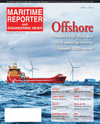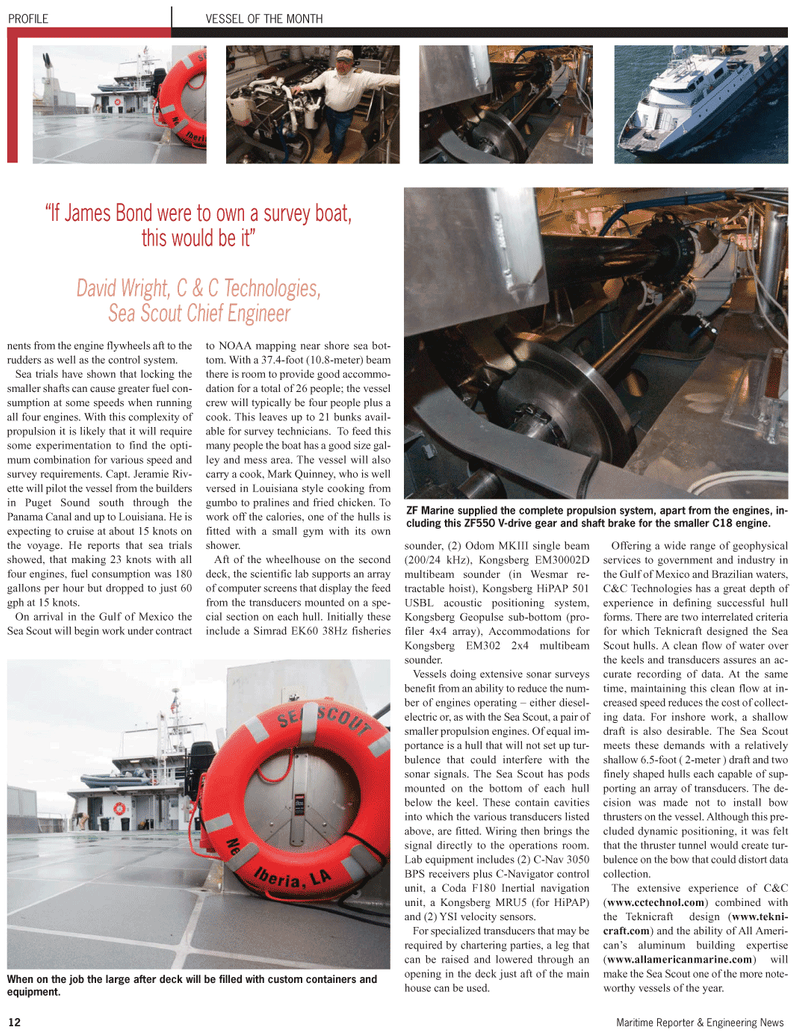
Page 12: of Maritime Reporter Magazine (April 2012)
Offshore Deepwater Annual
Read this page in Pdf, Flash or Html5 edition of April 2012 Maritime Reporter Magazine
12Maritime Reporter & Engineering News PROFILEVESSEL OF THE MONTH nents from the engine flywheels aft to therudders as well as the control system. Sea trials have shown that locking the smaller shafts can cause greater fuel con-sumption at some speeds when runningall four engines. With this complexity of propulsion it is likely that it will require some experimentation to find the opti- mum combination for various speed and survey requirements. Capt. Jeramie Riv- ette will pilot the vessel from the builders in Puget Sound south through thePanama Canal and up to Louisiana. He is expecting to cruise at about 15 knots on the voyage. He reports that sea trials showed, that making 23 knots with all four engines, fuel consumption was 180 gallons per hour but dropped to just 60 gph at 15 knots. On arrival in the Gulf of Mexico the Sea Scout will begin work under contract to NOAA mapping near shore sea bot- tom. With a 37.4-foot (10.8-meter) beam there is room to provide good accommo- dation for a total of 26 people; the vessel crew will typically be four people plus a cook. This leaves up to 21 bunks avail- able for survey technicians. To feed this many people the boat has a good size gal- ley and mess area. The vessel will also carry a cook, Mark Quinney, who is well versed in Louisiana style cooking from gumbo to pralines and fried chicken. To work off the calories, one of the hulls is fitted with a small gym with its own shower. Aft of the wheelhouse on the seconddeck, the scientific lab supports an array of computer screens that display the feedfrom the transducers mounted on a spe-cial section on each hull. Initially theseinclude a Simrad EK60 38Hz fisheries sounder, (2) Odom MKIII single beam (200/24 kHz), Kongsberg EM30002D multibeam sounder (in Wesmar re- tractable hoist), Kongsberg HiPAP 501 USBL acoustic positioning system,Kongsberg Geopulse sub-bottom (pro- filer 4x4 array), Accommodations for Kongsberg EM302 2x4 multibeam sounder. Vessels doing extensive sonar surveys benefit from an ability to reduce the num- ber of engines operating ? either diesel-electric or, as with the Sea Scout, a pair of smaller propulsion engines. Of equal im-portance is a hull that will not set up tur- bulence that could interfere with the sonar signals. The Sea Scout has pods mounted on the bottom of each hullbelow the keel. These contain cavities into which the various transducers listed above, are fitted. Wiring then brings the signal directly to the operations room.Lab equipment includes (2) C-Nav 3050 BPS receivers plus C-Navigator control unit, a Coda F180 Inertial navigation unit, a Kongsberg MRU5 (for HiPAP) and (2) YSI velocity sensors. For specialized transducers that may be required by chartering parties, a leg that can be raised and lowered through an opening in the deck just aft of the mainhouse can be used. Offering a wide range of geophysical services to government and industry in the Gulf of Mexico and Brazilian waters, C&C Technologies has a great depth of experience in defining successful hull forms. There are two interrelated criteria for which Teknicraft designed the Sea Scout hulls. A clean flow of water over the keels and transducers assures an ac- curate recording of data. At the same time, maintaining this clean flow at in- creased speed reduces the cost of collect-ing data. For inshore work, a shallow draft is also desirable. The Sea Scout meets these demands with a relatively shallow 6.5-foot ( 2-meter ) draft and two finely shaped hulls each capable of sup- porting an array of transducers. The de- cision was made not to install bow thrusters on the vessel. Although this pre- cluded dynamic positioning, it was felt that the thruster tunnel would create tur- bulence on the bow that could distort data collection. The extensive experience of C&C (www.cctechnol.com ) combined withthe Teknicraft design ( www.tekni- craft.com) and the ability of All Ameri- cans aluminum building expertise (www.allamericanmarine.com ) willmake the Sea Scout one of the more note- worthy vessels of the year. When on the job the large after deck will be filled with custom containers and equipment.ZF Marine supplied the complete propulsion system, apart from the engines, in- cluding this ZF550 V-drive gear and shaft brake for the smaller C18 engine. If James Bond were to own a survey boat, this would be it? David Wright, C & C Technologies, Sea Scout Chief Engineer

 11
11

 13
13
